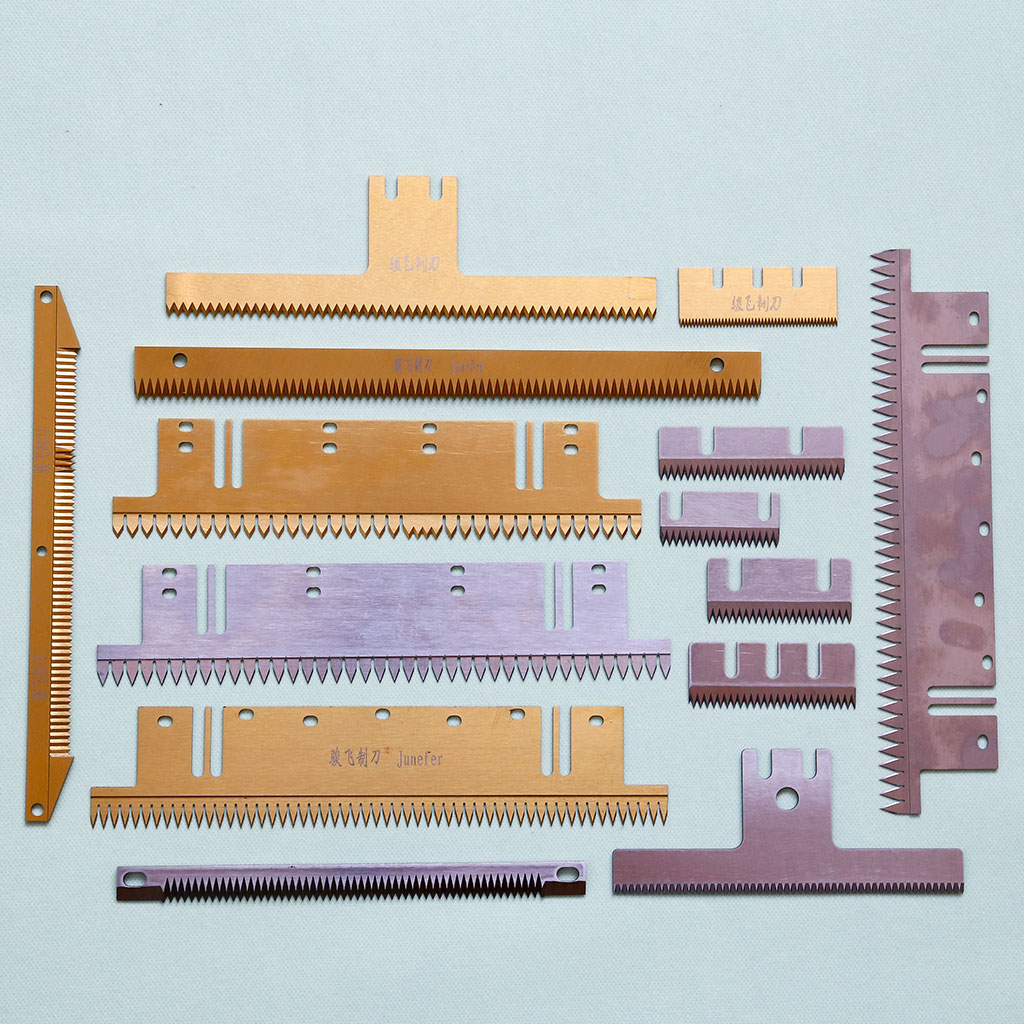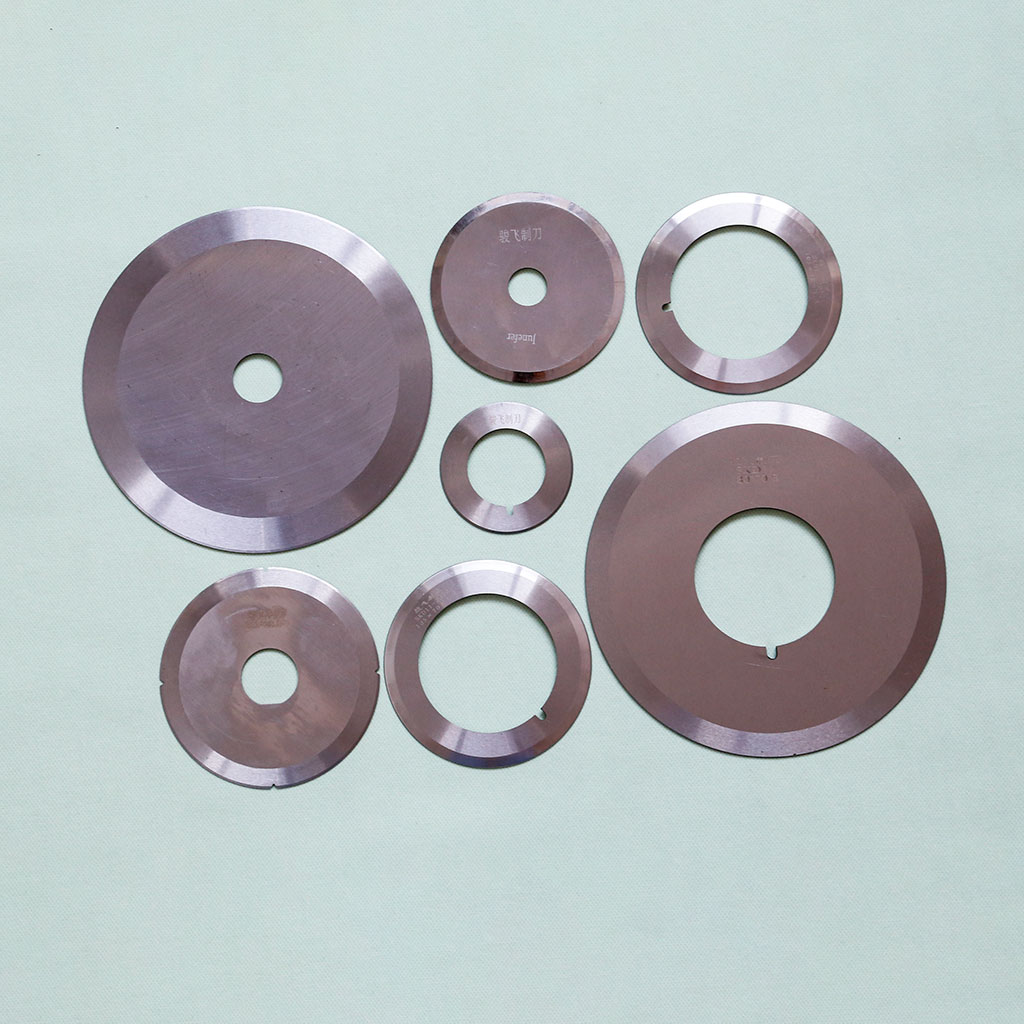1. Teeth Blade Serious
Teeth blades, also known as serrated blades or toothed cutting knives, are widely used in the food packaging industry, particularly for cutting the outer sealing packaging and various types of flexible packaging bags. These blades are essential in ensuring clean, efficient, and user-friendly cuts, especially in high-speed automated packaging lines. The selection of blade type and material is based on the packaging film’s thickness, material properties, and tearing requirements.
Common Types of Teeth Blades
There are several types of teeth configurations commonly used in food packaging applications. Each tooth shape offers unique cutting characteristics, depending on the application:
Single-Sided Teeth
These blades have teeth on only one side, producing a wavy or serrated cut edge. This type of cut is often seen on snack bags, plastic films, and flow pack packaging. The wavy edge is aesthetically pleasing and helps prevent sharp edges, making it safer for consumers.Double-Sided Teeth
Featuring symmetrical teeth on both sides, double-sided blades create a straighter and more even cut. This style is preferred for packaging that demands precise and clean cuts, such as vacuum-sealed food packages or resealable bags. It ensures minimal tearing during production and contributes to a professional package appearance.Dashed-Line Teeth (Perforation Blades)
Dashed-line teeth are designed not to cut completely through the material. Instead, they create perforated lines—a series of small cuts that leave uncut intervals. This design is perfect for tear-open packaging, as it allows end users to open the package easily without scissors. Common applications include instant noodle sachets, condiment packets, and other single-use food products.Cross Teeth
Cross-toothed blades are used to handle tougher or thicker packaging materials, such as multi-layer composite films or heavy-duty plastic wraps. These blades are engineered for high durability and provide reliable cuts even in demanding packaging processes. They are especially effective for packaging with high tensile strength and strong tear resistance.
Materials Used in Teeth Blade Manufacturing
The performance and longevity of a teeth blade greatly depend on the type of steel used. Each material has its specific characteristics in terms of hardness, wear resistance, corrosion resistance, and cost-efficiency. Common materials for manufacturing teeth blades include:
65MN: A high-manganese carbon steel offering good wear resistance and hardness. Suitable for standard cutting applications where cost-effectiveness is a priority.
SK-5: A Japanese high-carbon tool steel known for its sharp edge retention and hardness. Ideal for blades requiring frequent high-speed cutting.
SUS-440C: A high-carbon stainless steel that provides excellent corrosion resistance and high hardness (up to HRC 58+), commonly used for food-grade cutting tools.
420-J2: A moderate stainless steel option that balances corrosion resistance and toughness. Suitable for general-purpose food packaging cuts.
SKD-11: A high-performance cold work tool steel, similar to D2 steel, offering excellent wear resistance. Often used for high-precision blades with long life cycles.
SKH (e.g., SKH-9, SKH-51): High-speed steel, suitable for ultra-durable applications requiring high heat resistance and exceptional sharpness retention
2. High-Precision Circular Blades
📌 Product Description
High-precision circular blades are extensively used for slitting and trimming lithium battery components, electronic materials, rubber sheets, industrial paper rolls, plastic films, aluminum foil, and other flexible or layered materials. These blades are engineered for minimal cutting resistance and maximum wear resistance, ensuring clean and accurate cuts even under high-speed and high-load conditions. In critical industries like lithium battery production, the blade’s precision often reaches micron-level tolerances, where any deviation may affect downstream product quality.
All blades are manufactured using premium-grade imported steels and powder metallurgy alloys, selected for their hardness, toughness, and thermal stability. This guarantees superior edge retention and extended service life, even in demanding production environments.
🛠️ Application Fields
- Slitting of lithium battery electrodes and separators
- Precision trimming of electronic components
- Longitudinal cutting of rubber, tape, and composite materials
- High-speed slitting of paper rolls, plastic films, and aluminum foils
- Integrated into packaging machinery for film, foil, and flexible material cutting
🔩 Main Materials
| Material Code | Description |
|---|---|
| SKH-9 | High-speed steel with excellent durability and hardness |
| SKD-11 | Cold work die steel with outstanding wear resistance |
| LD | Versatile alloy tool steel for medium-load cutting applications |
| W6Mo5Cr4V2AL | M2-equivalent HSS with excellent edge retention and toughness |
| H13K | Hot work steel offering thermal shock resistance and edge stability |
| M42 | Cobalt-alloy high-speed steel with superior red hardness |
| K30 | Fine-grain alloy steel ideal for precision cutting |
| ASP60 | Powder metallurgy steel with HRC 65+ hardness and extreme wear resistance |
📐 Technical Specifications (Customizable)
| Parameter | Specification Range |
|---|---|
| Outer Diameter (OD) | 20mm – 300mm |
| Inner Diameter (ID) | 6mm – 100mm |
| Thickness | 0.1mm – 10mm (±0.002mm tolerance) |
| Hardness | HRC 58 – 68 (depending on material) |
| Surface Treatment | Polishing, coating, nitriding, titanium plating, etc. |
| Precision Tolerance | Parallelism and concentricity ≤ ±2μm |
📞 OEM/ODM Customization Available
We provide full customization services based on your drawings or specifications. Blade dimensions, materials, edge angles, tooth shapes, and surface coatings can all be tailored to your production needs. Contact us today for a professional quote or technical consultation.


